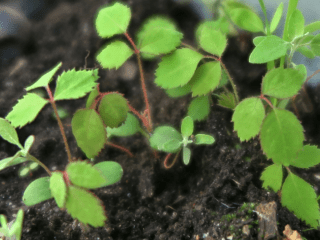Content
Dog rose does not differ in decorativeness, but gardeners often plant it in their personal plots for the sake of useful properties. Rose canina is widely used not only in folk, but also in official medicine, its beneficial effect on the body has been scientifically proven. Caring for dog rose hips is extremely simple, but treatment should be started only after consulting a doctor.
What does the botanical description of dog rose look like?
Dog rose (Rosa Canina), also known as “dog rose”, “wild rose” or “rooster berries”, is one of the numerous representatives of the genus Rosehip. He, in turn, is part of the Pink family.
The unusual Latin name for dog rose emphasizes the "value" of the canina rose in comparison with the "cultivated" roses. But there is another version, according to which, several centuries ago, the plant was actively used to treat dog bites.
Rosa canina is a densely deciduous shrub, reaching 1.5-2.5 m in diameter. The branches are powerful, but they are practically never straight. A noticeable arcuate bend is characteristic. The bark is greenish-brown; with prolonged exposure to direct sunlight, it changes its shade to brick or dull red.
There are relatively few thorns on the main shoots of the canina rose, in shape they resemble sickles flattened from the sides. Peduncles are literally dotted with them. On them, the thorns are bent even more, turning into some kind of hooks.
The leaves of the dog rose are pinnately dissected, 7-9 cm long. Normally, they consist of seven elliptical "segments" with a pointed tip, but sometimes there are five or nine. The edge is carved with small denticles, the central vein is covered with short sparse "villi", and there is a narrow stipule at the base of the leaf.
Dog rose flowers are often solitary, but there are also inflorescences-shields (3-5 pieces). The shade of the petals ranges from pure white and pastel pink to crimson and crimson. The diameter of the flower is 5-8 cm, it has 5-7 petals. The main "wave" of flowering occurs at the end of May, June, in July single buds open. Aroma, even light, flowers of dog rose hips are deprived.
The fruits of the canina rose are round, broadly oval or ovoid, 1.5-2.5 cm in diameter, with a smooth, glossy red-orange skin. They ripen in the second half of August.
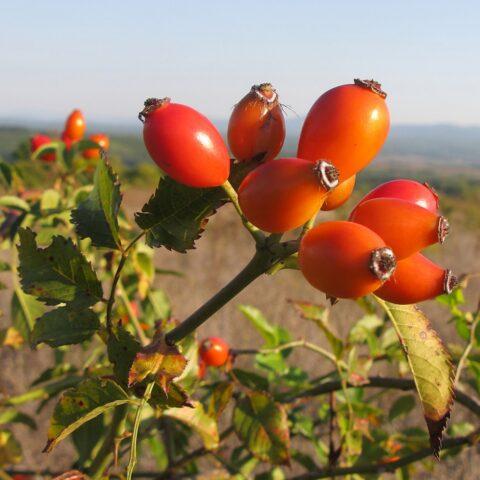
The content of the canina rose fruit - numerous seeds covered with tough villi
How to tell a dog rose from a regular one
The "common" rosehip is known to botanists as "May" or "wrinkled". Its main difference from the dog is the leaf plates. In the first case, their surface is wrinkled, in the second - smooth.
You can also pay attention to the bracts. In dog rose, they are tightly pressed to the peduncles, in May they stick out to the sides, resembling "the sun with rays."
The easiest way to distinguish between these species is during flowering. The opening buds of the common rose hips emit an amazing scent.
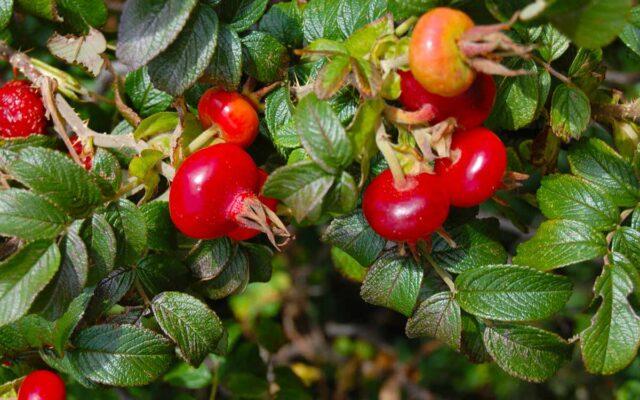
The fruits of the wrinkled rosehip are bright red, slightly flattened
Differences between dog rose and cinnamon
The main difference between cinnamon and dog rose is the shade of the bark. Even on young shoots in the first, it is brown, without any greenish tone. In him, like in wrinkled rose hips, unlike the canina rose, the bracts are bent outward.
The appearance of the thorns also differs. In cinnamon rose hips, they are thin and straight. Relatively rare on shoots, concentrated at the base of the leaves.
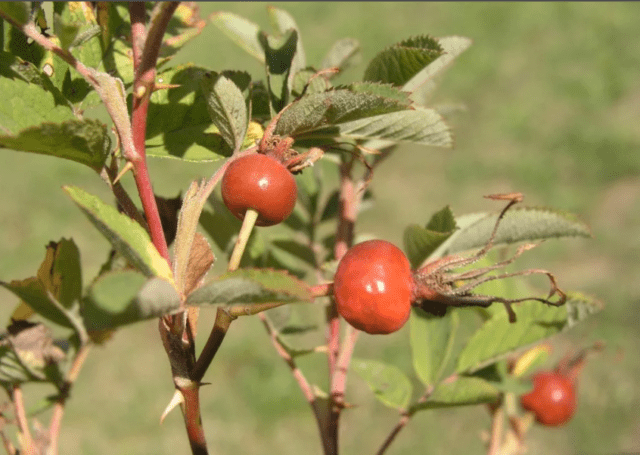
Rosehip cinnamon "wins" in the utility of all other varieties
Where the canina rose grows
The natural habitat of dog rose (like many members of the family) is very wide. This is practically all of Europe, Western and Central Asia, North Africa. The canina rose is easy to find in the European part of Russia.
The dog rose "chooses" the place of growth, also not being particularly picky. It is found in any not too dense forests, slopes and slopes, overgrown with grass or other shrubs, on the banks of reservoirs, along roadsides, on wastelands.
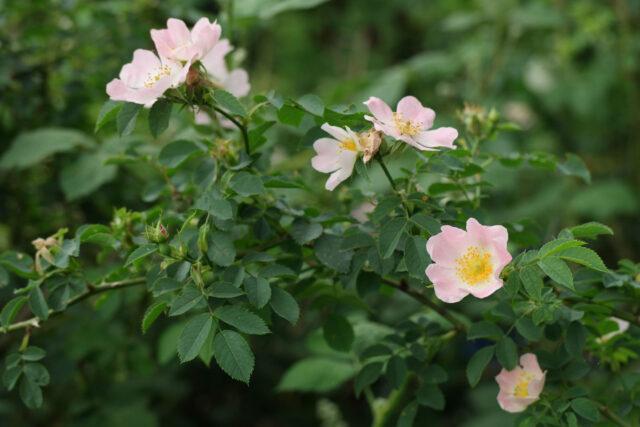
In a warm climate (Caucasus, Black Sea region), the canina rose actively grows, forming almost impenetrable thickets
Chemical composition and medicinal properties
In folk medicine, dog rose is valued mainly for its record high content of vitamin C, which is useful for restoring immunity and simply for maintaining the body's tone. But there are canina and other vitamins in the fruits of the rose:
- A - useful for vision and immunity;
- K, is necessary for normal blood clotting;
- R - strengthens the walls of the capillaries, helps maintain the permeability of the blood vessels;
- group B - are involved in the synthesis of enzymes, some hormones, erythrocytes and leukocytes.
Dog rose hips also contain:
- flavonoids;
- tannins;
- pectins;
- fruit acids (malic, citric);
- essential oils;
- organic sugars (glucose, sucrose, fructose);
- kaempferol, quercetin, lycopene, rubixanthin;
- macro- and microelements (potassium, phosphorus, magnesium, sodium, zinc, iron, selenium, copper, manganese, chromium, cobalt, molybdenum).
All these substances in the complex provide the dog rosehip with the properties that are in demand in folk medicine:
- bile and diuretic;
- antiviral and anti-inflammatory;
- wound healing, hemostatic;
- immunostimulating, antioxidant;
- antispasmodic.

The health benefits of dog rose hips are officially recognized
Traditional medicine experts recommend dog rose hips for the following health problems:
- vitamin deficiency, including seasonal spring deficiency and provoked by prolonged adherence to a strict diet;
- immunity that has worsened after a long illness, a serious surgical intervention;
- frequent colds, acute respiratory infections, acute respiratory viral infections;
- anemia;
- pathology in the process of metabolism, disturbed hormonal background;
- atherosclerosis, especially if it is necessary to clean blood vessels not only from cholesterol "plaques", but also from fatty deposits;
- hypertension, coronary heart disease;
- pneumonia, whooping cough and other diseases of the bronchopulmonary system, accompanied by inflammation;
- stones in the urinary, gall bladder, kidneys;
- eczema, psoriasis, any dermatological diseases;
- the presence of long non-healing wounds, ulcers, burns on the skin and mucous membrane;
- a stomach or intestinal ulcer;
- decreased gastric secretion;
- liver disease;
- some diseases of the musculoskeletal system (rheumatism, gout);
- myopia, hyperopia in the early stages of development;
- in women - excessively heavy menstruation, frequent uterine bleeding.
The substances useful for health are concentrated mainly in the shell of the dog rose hips. Less commonly in folk medicine, the leaves, seeds, roots of the canina rose are used.
Cooking methods
In folk medicine, dog rose is used in different ways. But the most popular remedies are made from its fruits.
Canina rose fruit decoction
To prepare it, you will need 80-100 g of dry raw materials and 1 liter of clean water. The process is extremely simple:
- Wash the dog rose fruit well.
- Boil water in a saucepan.
- Without removing it from the fire, pour the canina rose fruits into boiling water. Cook over low heat for 5-7 minutes.
- Cover the pan tightly with a lid, wrap with a towel, leave for 5-6 hours.
- Strain the ready-made broth before use, squeeze the berries themselves.

The taste of the canina rose decoction is, in principle, not bad, but you can add a little lemon juice or honey
Dog rose tea
There are a lot of recipes, but tea is always prepared the same way. Take a decoction of dog rose hips, add the rest of the ingredients (if necessary, grind them beforehand), let it brew for 5-6 hours under a closed lid.
You can add to the broth of dog rose hips (proportions are selected arbitrarily, to your taste):
- dried plain or black chokeberry, black currant, raspberry;
- fresh or dry mint, lemon balm;
- cardamom, cinnamon, anise;
- large leaf tea (black or green);
- fresh sour green apples.

Prepared tea from the fruit of the canina rose is filtered before use.
Dog rose syrup
Required Ingredients:
- peeled fresh fruits - 1.5 l;
- sugar - 1.5 kg;
- water - 2 l.
How to make canina rose syrup:
- Boil water, add berries to a saucepan.
- Cover, simmer for 30-45 minutes over low heat.
- Remove the pan from the stove, wrap it with a towel, let it brew for 10-12 hours.
- Drain the broth into another container, squeeze the berries there, pour the sugar.
- Cook over medium heat until thickened (about 30-40 minutes after boiling).
- Pour immediately into sterilized glass jars, bottles, cork. Allow to cool naturally.

Store canina rose syrup in the refrigerator or just in a cool dark place
Alcohol tincture
You need to take 400-500 g of fresh whole or peeled canina rose fruits and pour them with a liter of vodka or ethyl alcohol diluted to the appropriate strength in a glass bottle or jar.
The container is left for 15-20 days in a dark place to infuse, vigorously shaking the contents daily. The finished tincture is filtered.

It is not necessary to store the tincture in the refrigerator, but it must be protected from direct sunlight.
Application of dog rose hips
Traditional medicine specialists recommend dog rose hips for many diseases. Prior consultation with a doctor is required.
With pancreatitis and gastritis
With an exacerbation of the disease, it is recommended to drink a quarter of a glass of broth three times a day, about half an hour before meals. In the stage of remission for prevention, the "dose" is reduced to 2 tbsp. l.
For liver diseases
About a glass of broth is drunk three times a day, half an hour before meals. To enhance the effect, before closing the pan and leaving the liquid to infuse, add 2-3 tbsp. l. oatmeal crushed into flour.
The resulting product (you need to strain it, squeeze the dog rose and oatmeal) is drunk in a glass, three times a day, 1.5-2 hours after eating. In total, you need three courses of ten days with breaks between them for 2.5-3 weeks.
With hypertension
To normalize blood pressure, it is constantly recommended to drink any dog rose tea.In the stage of exacerbation of the disease - take half a glass of broth or 1 tsp. syrup three times a day immediately after meals. To enhance the effect, you can prepare the product from a mixture of canina rose fruits and cranberries.
With a cold
For colds, a decoction of dog rose hips with the addition of dry raspberries helps. They cook it, as usual, drink it warm, about a liter per day. To relieve a sore throat, take 1/2 tsp after meals. syrup. For the prevention of colds, teas are recommended.
Slimming
The calorie content of the infusion from the fruits of the canina rose is about 50 kcal per 100 ml. It normalizes metabolism, activates digestion, helps to remove toxins and toxins from the body. Those who follow a diet are advised to drink about half a glass of broth 15-20 minutes before meals.
Contraindications
Like any remedy in demand in folk medicine, dog rose has contraindications for use:
- chronic gastritis with increased acidity of gastric juice;
- hereditary predisposition to thrombophlebitis;
- many diseases of the cardiovascular system, for example, endocarditis;
- hypotension;
- frequent constipation;
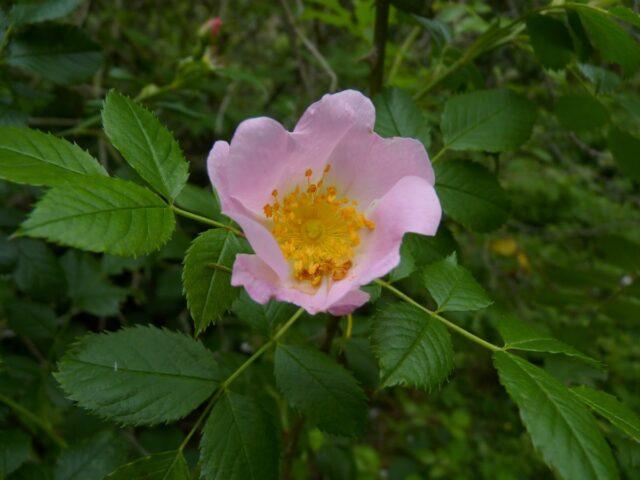
Canina rose allergy manifests itself with varying degrees of intensity.
If you take funds based on dog rose hips immoderately, vitamin C hypervitaminosis is quite likely. This does not threaten life, but the symptoms are unpleasant:
- general weakness, drowsiness;
- increased body temperature, redness of the skin and mucous membranes;
- persistent migraines;
- attacks of dizziness and nausea;
- stomach cramps, heartburn;
- diarrhea.
In addition, with regular use, ascorbic acid contained in dog rose hips negatively affects the condition of the tooth enamel and oral mucosa. And the villi that cover the canina rose seeds, getting into the stomach and intestines, can damage the tissues. But this can be avoided if each time after taking the product, rinse your mouth thoroughly with warm water and gently clean the fruits.
Features of growing and care
Rosa canina, which is obvious from its description and photo of gardeners, is, in fact, a weed on the site. Caring for her takes a minimum of time and effort. Especially if you choose the right place for disembarkation.
Her "requirements":
- good illumination;
- availability of protection against cold drafts;
- fertile soil (black soil, loam, gray soil);
- lack of groundwater approaching the soil surface closer than 2.5-3 m (the root system of the dog rose is very powerful, the roots go into the soil by 4-5 m).
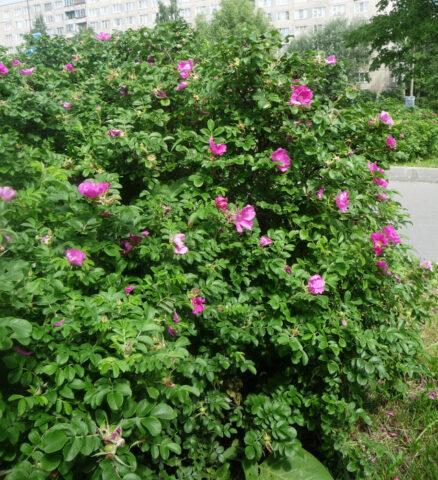
In the shade, the canina rose will not die, but it will bloom and bear fruit poorly
The best time to plant a dog rose is spring. In the fall, you will have to carefully control soil moisture. The canina rose propagates easily both in a vegetative (cuttings, layering) and generative (seeds) way.
Caring for dog rose hips includes only standard agrotechnical measures:
- Watering. Young canina roses in the heat require 20-30 liters of water every 12-15 days, adults (already fruiting) - 30-40 liters. Often the plant can do with natural precipitation altogether.
- Mulching. Not required, but highly desirable. Allows you to abandon weeding and loosening, to increase the intervals between waterings.
- Top dressing. In fertile black earth soil, fertilizers are not needed for dog rose hips. If the soil is poor, it is fed three times per season - at the beginning and at the end of the active growing season, after flowering. Canina rose reacts positively to both natural organic matter and store-bought fertilizers (universal or specialized for decorative flowering shrubs).
- Pruning.It is necessary that the dog rose does not "spoil the view" in the garden, as well as to facilitate the collection of fruits. It is desirable that the bush consists of 12-15 shoots at the age of three years. All branches growing downward, deep into the crown, are cut out deformed in the fall. Sanitary pruning is necessary in the spring.
- Preparing for winter. Frost resistance up to -40 ° С allows the canina rose to survive even in Siberia, in the Urals. Covering, falling asleep with humus or peat, it is recommended only seedlings for which this is the first winter.
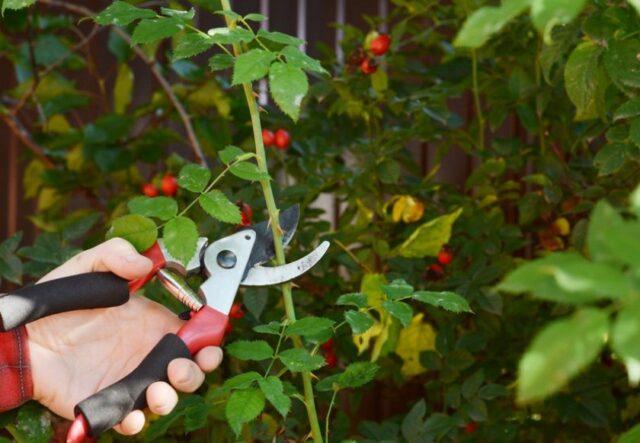
Pruning, even radical, the dog's rose tolerates easily
Unlike garden roses, dog rose hips are extremely rare. Pest attacks are also exceptional for him. In principle, competent care is sufficient for prevention. But many gardeners, in order to be on the safe side, in the spring and autumn process the canina rose itself and the soil in the near-stem circle with successive solutions of a fungicide and an insecticide of a wide spectrum of action.
Collection and procurement
Harvesting of fruits begins when the skin completely acquires the characteristic red-orange hue of a dog rose. This is approximately the last decade of August or the first days of September.
The canina rose is removed along with the sepals. During the collection process, specimens with mechanical and other damage are discarded. It is advisable to start processing immediately. As a last resort, you can wait 2-3 days. The berries are cut in half, the seeds are carefully cleaned.

Dog rose hips are harvested by wearing gloves and thick clothing
The fruits of the dog rose plant are dried along with the sepals in different ways, but you do not need to wash them in any case:
- naturally - in the attic or outdoors, in any sunny, well-ventilated place, providing protection from direct rays;
- in the oven;
- in an electric dryer.
The berries are always laid out in one layer and, if possible, so that they do not come into contact with each other. Drying is completed when the dog rose hardens and easily breaks with your fingers. But the skin should not turn black, retaining the original shade.
Store dried dog rose hips in a dark cool place with relatively low humidity, spread out in paper bags, linen bags, hermetically sealed plastic containers, glass jars.
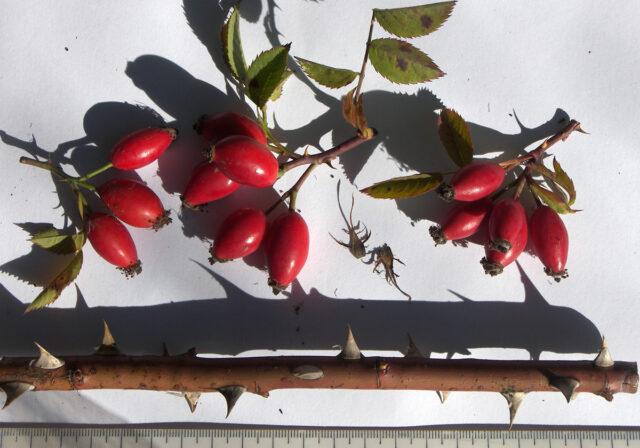
The shelf life of dried fruits of the canina rose is two years.
Conclusion
Growing dog rose is an easy task for any gardener. The canina rose is planted for the sake of the fruits, which are distinguished by a very rich chemical composition, which makes them useful in the treatment of various diseases. However, it must be remembered that traditional medicine is far from being "harmless." If used incorrectly and if there are contraindications, serious harm to health is possible.





